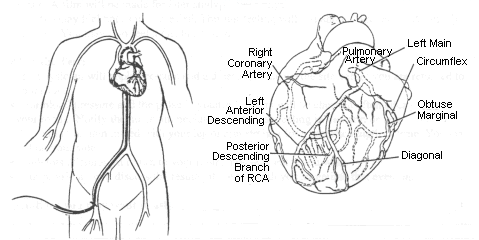What Is Cardiac Catheterization?
(also called Coronary Arteriogram, Coronary Angiography)
If your doctor suspects you have a blockage in the coronary arteries that feed your heart muscle, a test called a coronary arteriogram may be suggested. This test is done by a cardiologist, a heart specialist.
For this test, a catheter (a small tube) is inserted into an artery in your groin or arm and guided to your heart. There it is placed into each of the main coronary arteries and dye is injected. This dye shows the location and size of any blockage in the artery. The cardiologist studies each artery and decides the best treatment for you.
During this test, the cardiologist may inject the dye into the chambers of your heart to see how well the heart “pumps”. The cardiac catheterization is useful in studying conditions such as congenital abnormalities (an abnormal heart condition that you have had since birth) or valvular abnormalities (for example, a valve that has been damaged or is diseased).

Before the Test:
- Your physician will explain the procedure and its benefits and risks. You will have an opportunity to ask any questions. Then, you will sign a consent form.
- You will not be allowed to eat or drink anything after midnight before the test. A clear liquid breakfast may be allowed if your test is scheduled for later in the day.
On the morning of the Test:
- You will change into a hospital gown and be asked not to wear undergarments. Please remove any jewelry, hairpins, hair pieces or dentures. You may wear your glasses.
- A transporter will come to your room to take you to the Cath Lab where the procedure will be performed.
- An I.V. is started before the procedure. This will help your body to have enough fluids and serve as a route for I.V. medications.
- Your physician may order medications to help you relax. It may result in your mouth becoming dry. These may be given in the Cath Lab.
- Since the time varies for each test, please have your family come early. Your nurse will tell them where they can wait.
During the Test:
- The physician will find an artery in your groin or arm and give you an injection of "numbing medicine" before he places the needle, sheath (small tube) and catheter into the artery.
- Contrast material (dye) will be injected into the artery. This makes the vessels show up on x-ray. A film will be made for later study by your physician.
- The dye may feel warm as it is injected. This warm feeling will last about 5 seconds each time it is injected. You may also feel a fast heart beat.
After the Test:
- The nurse will apply pressure, remove the sheath and apply a dressing to the site before you are returned to your room.
- Your blood pressure and the pulse in your feet or arm will be checked often after you return to your room. Notify the nurse immediately if you lose feeling in that arm or leg.
- You will remain in bed with your leg or arm straight for a specific length of time. You may be able to tilt to one side with assistance.
- Drink lots of fluids on return to your room. You may eat if you wish.
- Your physician will discuss the results of the test with you sometime that evening.
